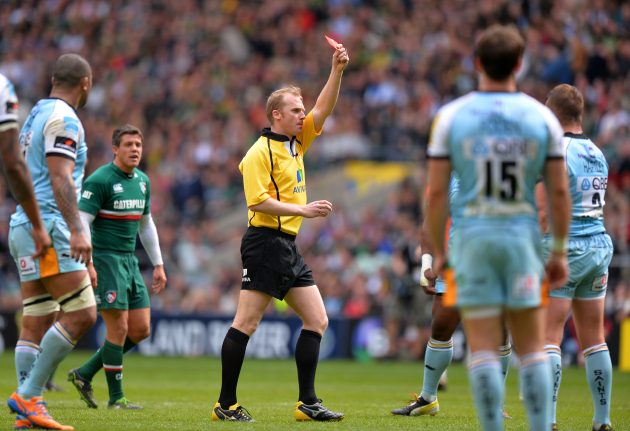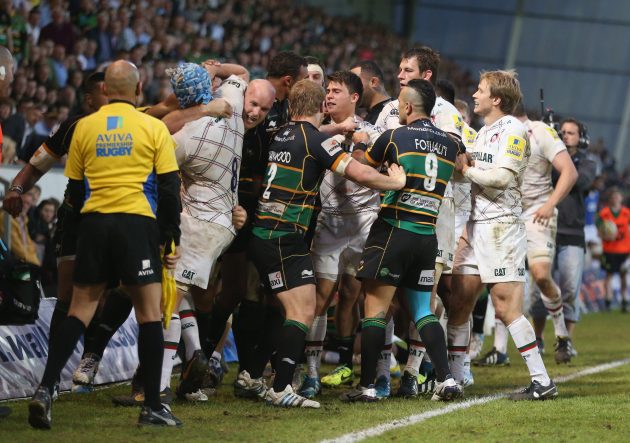Ahead of their Premiership semi-final this weekend, we look back on a brutal, controversial play-off trilogy between the East Midlands foes
The Leicester v Northampton rivalry, 2011-14
Leicester Tigers v Northampton Saints, in the play-offs, between 2011 and 2014. The description provokes instant memories for Christian Day.
“I played about 350 professional games,” the former Saints lock says. “Those three stand out more than most.”
The great East Midlands foes are set for another mouth-watering Gallagher Premiership semi-final this Saturday at Welford Road. It is the first post-regular season encounter between the pair since 2014, when a play-off meeting was almost an annual event.
With drama, physicality and controversy underpinning those three contests in four seasons, it is unsurprising that Day can recall them with ease. Here’s a quick recap…
Welford Road, 2011: In an attritional semi-final won by Tigers after a bulldozing Alesana Tuilagi try, brother Manu Tuilagi takes the headlines with a haymaker to Chris Ashton’s temple.
Twickenham, 2013: Leicester beat Northampton in the Premiership final, but Saints captain Dylan Hartley steals the show by getting sent off for allegedly calling referee Wayne Barnes a “f***ing cheat”.
Franklin’s Gardens, 2014: Tom Wood’s 78th-minute try gives Northampton a 21-20 semi-final win, but Salesi Ma’afu’s punch on Leicester’s Tom Youngs, which earned the Saints prop a red card, is just as pertinent a memory.
The Leicester v Northampton rivalry, 2011-14
“It was genuine,” insists Day, who studied local rivalries as part of his MBA in Sports CEO. “There was no manufacturing it. I don’t want to say dislike, but a real rivalry.”
Even for players less aware of the derby in their youth, such as Fijian back Vereniki Goneva, it left an impression.
“It definitely stands out,” says Goneva, a scorer in the 2013 final. “I still remember every moment and know how big the derby is. The red and yellow cards were always part of this game.”
Indeed, in ten league matches between 2011 and 2015, there were 15 yellows and five reds. Why was the feud so intense in this period?
Wood’s explanation goes beyond local bragging rights: “The rivalry stemmed from being two top teams. If Leicester were rubbish and bottom of the league, or if we were mid-table, the rivalry would not have had the same vibe.”
That several positional match-ups involved duels between England internationals enhanced the tension. Back-rower Wood adds: “Myself and Tom Croft, Hartley and Tom Youngs, Lee Dickson and Ben Youngs, Luther Burrell and Manu, these were all head-to-heads going on within the game.”
Ahead of the 2011 semi-final, a 19-year-old Manu was destined to join Ashton as an England regular, but that did not stop him coming to blows with the then Saints (now Tigers) winger.
Wood was injured for the game but can still recall it in depth: “I love Manu, he is a physical player and when we were England team-mates he was the first name on the teamsheet.
“But he hit him (Ashton), not back ten, to slow the game down. Then when Chris reacted with a little bit of a shove, he took three haymakers to the face.”
Even Goneva, not a Leicester player for another 12 months, remembers the moment. “It happened a year before I signed for Leicester. When I arrived, I saw all the highlights and from then I knew all about it.”
Tuilagi received only a yellow card from Barnes, the same punishment as Ashton. Tuilagi’s retrospective five-week ban emphasised Northampton’s misfortune.

Ashton, head bandaged after the punch-up with Tuilagi, sees yellow (Getty Images)
“I watched that and scratched my head in disbelief,” says Wood.
Scott Hamilton, playing at full-back for Leicester that day, was no less surprised: “I remember the punch and thinking that we could be in trouble but, thankfully for us, he did not get sent off like he probably should have.”
Hartley was not so lucky at Twickenham two years later. His red ended an extraordinary sequence, which was sparked by Saints fly-half Stephen Myler mistakenly believing he could end the first half by kicking a 22-metre dropout directly into touch.
The error led to a Leicester scrum that yielded a penalty in front of the Northampton posts. Hartley then uttered his infamous phrase and Barnes, who had warned him minutes earlier about his language, brandished the red.
Wood and Day were behind hooker Hartley in the scrum, but both insist they could not hear their captain. They therefore accept his explanation that his words were directed at opposite number Youngs, not the referee.
“Hand on heart, I did not hear a single thing,” maintains Day. “There had been a few pushes and shoves in previous scrums and this was another one that came up together. Next thing we know, the whistle went with a different intensity.”

On the stroke of half-time, Hartley is sent off by Barnes in the 2013 final (Getty Images)
In contrast, Tigers hooker George Chuter, watching on from the touchline, suspects his team-mates recognised they could exploit Hartley’s frustration.
“We knew we could get under Dylan’s skin,” he says. “He had a bit of a short temper at the best of times and he had been frustrated by a few scrums beforehand.
“He made a few excuses afterwards, but speaking to some of the lads in that scrum, it was pretty clear what he said and who he was saying it to.”
The decision allowed Leicester to take a 37-17 victory and a tenth Premiership title, but the red card had diluted the occasion for some.
“There was relief that we were probably going to win, but you never want it decided like that,” says Hamilton. “I did not like to see it. You want it to be 15 on 15.”
The sense of unfinished business set-up the 2014 semi-final nicely. This time, Northampton possessed home advantage.
And although Tigers led by 11 points after a storming start, Northampton roared back in the final quarter, which culminated with Wood’s iconic score. It secured a seminal victory for a team who had developed a habit of falling short on the big occasion, and they would win an inaugural Premiership title with another last-minute try two weeks later.
“I remember going into overdrive and thinking this cannot happen again,” reflects Wood on the semi-final. “It could not be taken away from us for whatever reason. I did not care if we had to play with ten men, we had to find a way to win.”
For the Saints fans, Wood’s try was cathartic. “It was the loudest noise I have ever heard on a rugby pitch,” says Day. “I’ve never had my ears ring like that before. It was crazy.”

Wood lets out a roar after edging Saints ahead in the 2014 semi-final (Getty Images)
Northampton’s late comeback commenced in spite of Ma’afu emulating Tuilagi with his shot on Youngs on 56 minutes. With the Television Match Official more prevalent than in 2011, the Australian saw red.
“You did not see a lot of people punching by that time,” Chuter says. “To see someone properly knock someone was quite unusual.”
After the game, Youngs’s Twitter interaction with Ma’afu demonstrated the mutual respect the sides, perhaps begrudgingly, had for one another.
@SalesiMaafu good shot mate, go well in the final. #rocky pic.twitter.com/LYOmWXaUrJ
— Tom Youngs (@TomYoungs87) May 17, 2014
“In rugby, the people you hate when you play against them would be your best mate if they were in your team,” says Wood. “It is nothing personal at the end of the day. It is hard for it not to feel like that in the moment and the immediate aftermath, but when you reflect on it, both teams gave a huge amount to the occasions.”
So, when the teams resume their play-off rivalry after an eight-year hiatus on Saturday, will it be a pleasant, cordial battle built solely on reluctant admiration?
Of course not. This is Leicester against Northampton in the Premiership semi-finals. It matters too much for such pleasantries.
“It is probably the purest derby there is in our sport. We are on each other’s doorsteps and it splits loyalties in some families,” says Chuter.
“You can’t overstate how much it means, particularly to the fans. It is a whole tinderbox waiting to go up and you could argue it is surprising there have not been more of those incidents.”
Wood is on the cusp of retirement and, with tongue firmly in cheek, does not rule out a return to the scenes of the infamous trilogy.
“The days of punches in Premiership games seem to be over now. But, if it’s going to happen, I imagine it will be in an East Midlands Derby.”
Download the digital edition of Rugby World straight to your tablet or subscribe to the print edition to get the magazine delivered to your door.
Follow Rugby World on Facebook, Instagram and Twitter.





